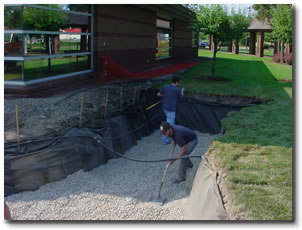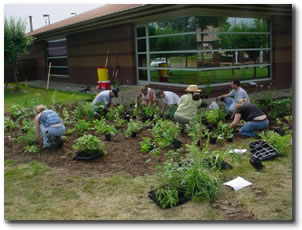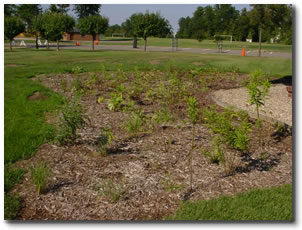Lower Grand Watershed Interactive Tool (WIT) - Rain Gardens





Lower Grand River 319 Project
Nonpoint Source Pollutants
Water Science Education
Interactive Mapping
Storm Water Management
Low Impact Development
Government Resources
History of the Watershed
Create a Watershed Management Plan
FYI on Local Water Issues Rain Gardens
LGRW Implementation Project
What is a Rain Garden?
The purpose of a rain garden is to protect and improve the water quality in a watershed by managing storm water runoff. Rain gardens are bioretention systems that allow water to filter into the ground on-site so that it doesn't contribute to stormwater runoff. Increased infiltration of water helps remove contaminates such as oil, grease, and nutrients. It also reduces the volume of water flowing overland that will eventually enter a nearby stream, ditch, or storm sewer system.
Spreading gravel for the Walker Library rain garden in Sand Creek Watershed
Putting in the Plants, Walker Library
Completed Walker Library rain garden, Sand Creek Watershed
Creating a Rain Garden
A shallow, saucer-shaped depression is created in the garden to hold rain as it soaks in. Soil replacement and additional preparation are sometimes needed for success. After the hole is dug a geotextile fabric is laid down and covered with a layer of gravel. A good soil mix for rain gardens is 50-60% sand, 20-30% topsoil, and 20-30% compost. Download this rain garden poster created by Rain Gardens of West Michigan for more information. (PDF, 612kb)
What kind of plants go in a rain garden?
Many rain gardens use native plants with deep rooting systems that are well suited for dealing with saturated soil when the garden is fully charged with runoff. Species of perennial plants native to our region are recommended because they are adapted to local conditions and will not need extra care once they are established. For complete steps download this rain garden fact sheet developed by the rain gardens of West Michigan. (PDF, 3.3mb)
Completing Your Rain Garden
A mulch of shredded hardwood is an integral part of your rain garden. It keeps the soil moist and ready to soak up rain, and makes your garden low-maintenance. Maintain your garden for the first couple of years by:
1. Water regularly until plants are established and then later on during droughts if practical.
2. Weed on a regular basis especially for the first year.
3. Spread a new layer of mulch each year or as needed. This reduces weeding and watering.
*Some of the information presented here has been taken from material created by Rain Gardens of West Michigan. Visit their website at www.raingardens.org for much more information.
Contact:
Grand Valley Metro Council
40 Pearl St. NW, Ste. 410 Grand Rapids, MI 49503 (616) 776-3876
[email protected]
